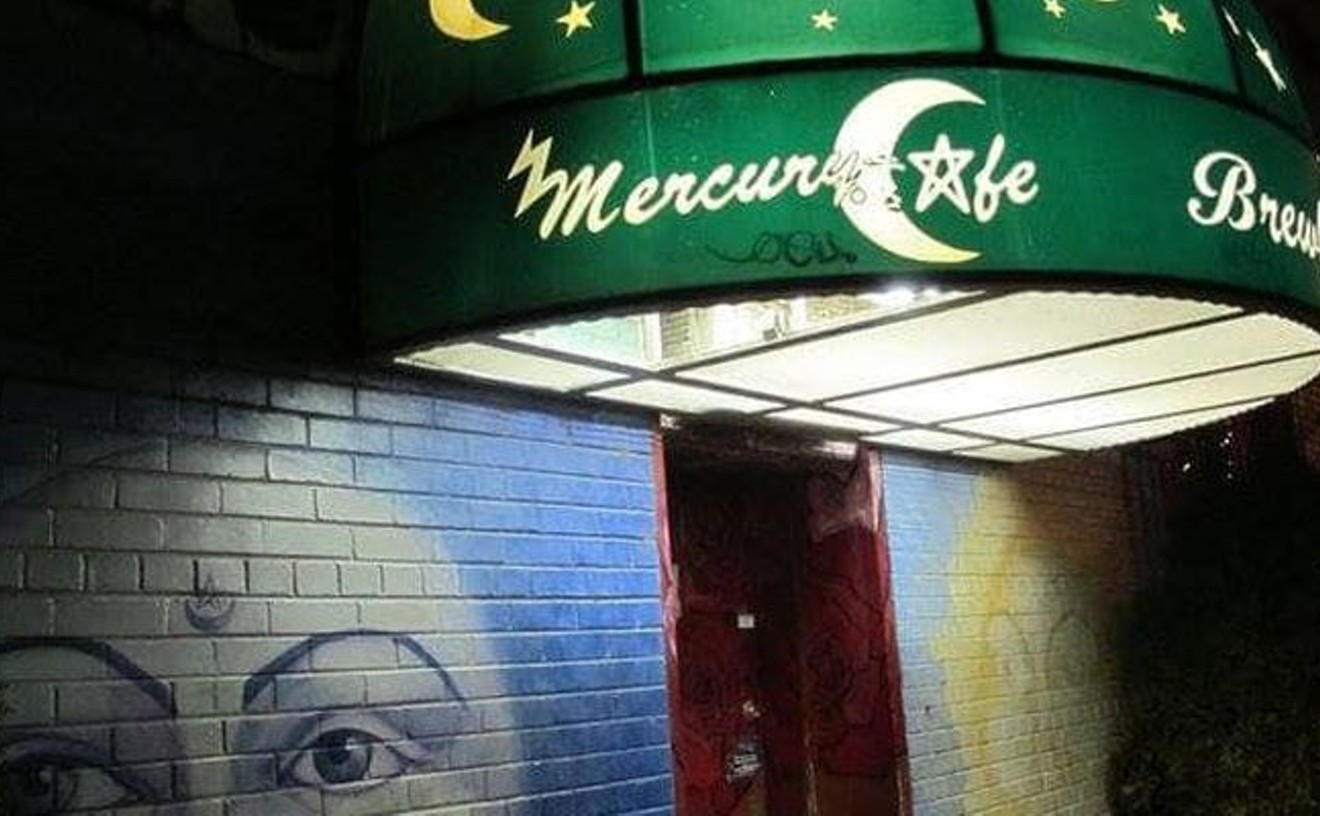Unfortunately, perhaps because participation is not limited to those with genuine cultural or religious connections to the holiday, these shows have mostly been pretty bad, and many pieces seemed to mock Mexican culture instead of paying homage to it. The most recent Pirate show was better than usual, though it still wasn't very good. Organized by the husband-and-wife art-activist team of Bob Luna and Martha Keating, it featured a mixture of sensitive and significant works intermingled with the irrelevant and irreverent ones.
But regardless of the dubious quality of the Pirate annuals, they have been important, since they raised the visibility of the obscure holiday and so set the stage for other, better shows that also observe the Day of the Dead in some fashion. One such show is Jose Guadalupe Posada: Mexican Printmaker, which currently occupies the two front galleries at Denver's Museo de las Americas. "There's so much interest in the Day of the Dead, we really felt we needed to do this kind of a show," says Museo director and founder Jose Aguayo, who selected inclusions and arranged the exhibit.
The Posada show takes up the broadsides and prints created by an important turn-of-the-century Mexican artist who is little known other than to art historians. But if the name Posada is unfamiliar, his images are not. His signature subject is calaveras (skulls), and for Posada, this also means entire skeletons. These cartoonish images are fairly well-known, if only through the work of other artists who make references to them.
Skeletons are particularly linked to the Day of the Dead, as are pumpkins, candies and graveyards. Such iconography would seem to mean that the Day of the Dead is the Mexican corollary to our own Halloween, but that's not entirely correct--though the two celebrations are linked by the Roman Catholic liturgical calendar. The Day of the Dead is actually two days: November 1, All Saints' Day, and November 2, All Souls' Day. Halloween, celebrated on October 31, appears on the Catholic calendar as the eve of All Saints' Day (as in the archaic All Hallows' Eve).
Though all three feast days are celebrated throughout the Catholic world, with Halloween having a hefty secular following, the Day of the Dead is uniquely Mexican (not counting those Pirate shows). It is the product of a cultural hybrid combining European-derived Catholicism with indigenous Meso-American traditions. The ancient Mexican Aztecs were particularly interested in blood sacrifice, and as a result, the skull was an important religious symbol to them. This has carried over into the Day of the Dead, with skulls used as images for holiday decorations and special sugar candies. Posada's calaveras prints at the Museo are another example of skeleton imagery used to celebrate the Day of the Dead.
However, as Museo director Aguayo points out, while the calaveras prints are among Posada's best-known images, they represent only a tiny fraction of the artist's oeuvre.
Posada was born in 1852 in Aguascalientes, a small town north of Mexico City. Little is known of his early life, other than that his father was a modestly successful baker. His older brother, Cirilio, was a teacher who instructed Posada in drawing, which led the younger man to apprentice, at the age of sixteen, in the lithography shop of Trinidad Perdroza. A precocious talent, Posada created for Perdroza satirical political cartoons that mocked the town's government and social order. Though none of these images are included in the show at the Museo, they must have been pretty good, since Posada and Perdroza were forced to flee Aguascalientes in 1872, in fear of retribution from the lampooned local authorities.
Posada settled for the next sixteen years in León de las Aldamas, where he produced a variety of printed articles including illustrations for books, cigar-box designs and more mundane projects such as diplomas and party invitations; he also taught lithography. In 1888 Posada relocated his print shop to downtown Mexico City, in the vicinity of the National Palace. The following year he began working for the publisher Antonio Vanegas Arroyo, whose shop was right next to the Academy of San Carlos, Mexico's most important art school. His relationship with Arroyo would last until Posada's death, in 1913.
Though Posada never was renowned in his lifetime, he was also never without a commission and produced a gigantic body of work with perhaps as many as 2,000 surviving pieces. Despite this tremendous output, Posada might have been totally forgotten if not for the Arroyo shop's address. In the 1920s, Posada was rediscovered by a new generation of Mexican artists who were associated with the Academy of San Carlos and who saw his work in the nooks and crannies--even the basement--of Arroyo's shop next door. Among Posada's earliest champions were Diego Rivera and Jose Clemente Orozco, two of the key figures in the Mexican mural movement of the '20s and '30s.
The artists of that movement made references to Posada's unique style, which is at once folkloric and modernist, because they saw it as quintessentially Mexican. The Mexican muralists also gave Posada an important connection to Colorado. In the 1930s, French artist Jean Charlot went to work with Rivera in Mexico, where he was exposed to the Posada prints. Years later, in 1947 and 1948, Charlot was serving as art-school director at the Colorado Springs Fine Arts Center. Charlot made a point of publicizing Posada's work, which he recognized as the chief inspiration for the Mexican muralist movement. The CSFAC was in a perfect position to benefit from Charlot's insight, because the institution's Taylor Museum had been created to collect art of the Southwest and Mexico. The Taylor Museum put together a collection of Posada's work and in 1947 commissioned the Arroyo firm to reprint a portfolio of 100 of the artist's woodblock prints.
The Taylor Museum has loaned the Museo many of the Posada broadsides included in the exhibition; others are on loan from the Denver Art Museum. The set of 100 woodblock prints, a few of which are hung on the wall (the rest are displayed in a showcase), are from the Museo's own permanent collection and were a gift of Denver collector Allen Espinlaub.
These posthumously printed woodblocks are quite different from the broadsides Posada did during his lifetime. The broadsides, which were sold on the street for a penny or so, were meant to be ephemeral--meant to be thrown away--so they were haphazardly printed on cheap newsprint. The woodblocks commissioned by the Taylor Museum, however, are meticulously inked and printed on fine rag papers--and they are beautiful. In one of the plates from the portfolio, a skull surmounts crossed engraver's tools in lieu of crossed bones; it is surely meant by Posada to be a self-portrait. The skull and tools are in a mottled black centered on a field of rich, creamy lavender.
Near the display devoted to the Taylor portfolio is another fine print that is also a later restrike, "Calavera del Montón (Francisco I. Madero)," a humorous caricature of Mexico's first revolutionary president as a strolling skeleton. It was originally done in a zinc-plate etching around 1910. Posada reveals the president as a drunken, sombrero-wearing peasant. Though undated, this print, like the works in the Taylor portfolio, is probably from the '40s, and it looks as though it may have been stamped at the CSFAC's long-closed but world-renowned print shop.
Not only did Posada depict the leading political figures of his day as skeleton sight gags, but he characterized his friends and fellow artists in the same way. In "Aqui Esta la Calavera del A. Vanegas Arroyo," an undated zinc-plate etching from around 1900, Posada has rendered his publisher as a bearded and bespectacled skeleton. The large image of Arroyo is set in a sea of smaller skeletons carrying out the many various labors associated with publishing. "Calaveras de Artesanos" has been printed from a plate of movable type and a zinc plate, which is engraved with a scene of skeletons working at different crafts. Posada uses specific tools and work tables to distinguish the various skeleton artisans that otherwise appear all alike.
In addition to the calaveras prints, Museo director Aguayo has included three tissue-paper cutouts made in 1950 by Mexican artist Lola Cueto that are based on Posada's images. Like many of the prints, these cutouts have been loaned to the Museo by the Taylor Museum. One inspired pairing has Cueto's purple cutout "Gran Fandango" hung next to its source, Posada's "Gran Fandango y Francachela," a type-metal engraving from the early 1900s that has been printed on pale-orange paper.
The paper cutouts are traditional decorations for the Day of the Dead and are often used to adorn the personal home altars that are also part of the celebration. Two of these altars have been custom-made for this show by two Colorado artists known for working in this peculiar form. On one side of the north gallery, diagonally facing the Museo's entrance, is a Day of the Dead altar by Maruca Salazar; opposite is one by Rita Wallace. Both altars are traditionally conceived and incorporate pictures of dead relatives, religious symbols and offerings of food and drink. Salazar's is the more thoroughly unified of the two, owing to the pink fabric that covers the entire altar, on which the icons and offerings have been placed. Also notable in Salazar's piece is the use of contemporary paper cutouts, not unlike the Cueto pieces.
The Jose Guadalupe Posada: Mexican Printmaker exhibit at the Museo de las Americas coincides with a larger exhibit at the Taylor Museum. Both provide a prelude to a national traveling show timed to go along with the recent publication of a new study on Posada's career by art historian Patrick Frank. Though he's now teaching at the University of Kansas, Frank conducted his research on Posada while he was at the University of Colorado in Boulder. Frank's efforts are reminiscent of Charlot's, since for the second time, someone working in Colorado has given Posada's reputation a considerable boost.
Jose Guadalupe Posada: Mexican Printmaker, through November 28 at the Museo de las Americas, 861 Santa Fe Drive, 303-571-4401.










